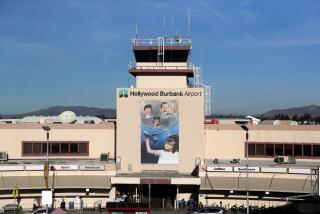United Ends Wide-Body Jet Flights at Burbank
- Share via
With hardly a trace of the publicity and protests that marked its beginning seven months ago, wide-body jet service came to an end at Burbank Airport over the weekend, at least for the time being.
Airport officials announced Monday that United Airlines has substituted a smaller, quieter plane for the Boeing 767s that have flown daily between Burbank and Chicago since May 1.
On Saturday, United began using Boeing 737-300s on the flights from Chicago that arrive in the evening and return the next morning. On Dec. 15, the airline had made the same substitution in another Chicago flight, which arrives and departs each afternoon.
Introduction of the 767, the largest commercial jetliner to fly into Burbank Airport, caused an uproar of homeowner protests over aircraft noise.
It also moved the Federal Aviation Administration to increase pressure for compliance with its longstanding demands for safety improvements at the 57-year-old airport, where the terminal building and aircraft parking areas are closer to runways than federal regulations now allow.
United heavily advertised the inauguration of its service from Burbank. On safety grounds, the homeowners objected both to the size of the plane and to allowing United, which at that time had no Burbank flights, to add to the number of flights there.
East-West Runway Banned
Because of the debate over safety that followed United’s application to use the 767, the FAA banned the use of the airport’s east-west runway for eastward takeoffs.
It also ordered the Burbank-Glendale-Pasadena Airport Authority to convert about 500 auto-parking spaces to an aircraft-parking apron. Both orders were designed to increase the area between the terminal and where the planes take off.
In a January letter released by the airport authority Monday, Kenneth R. Lemke, airport affairs administrator for United, gave no specific explanation for the withdrawal of the 767, but cautioned that the change might be seasonal, “depending upon overall operational requirements and market considerations.”
Lemke could not be reached for comment Monday at United’s Chicago headquarters.
Airport spokesman Victor J. Gill said United had a large number of 737s on order when it began service from Burbank and intended all along to withdraw the 767s from Burbank as soon as the new planes were delivered.
He said the 737-300 carries 141 passengers, 56 fewer than the 767, and is the latest and possibly the quietest of the new generation of quieter jetliners.
Airport officials said the substitution would trim 1.9 acres from the area around the airport where average aircraft noise exceeds the state standard.
News that the 767s have been replaced provided little consolation, however, to homeowners under takeoff routes south of the airport, said Richard Close, president of the Sherman Oaks Homeowners Assn.
‘There Are No Quiet Planes’
“What we focus on is not the acreage,” Close said. “It’s the number of flights. There are no quiet planes. To substitute one noisy plane for another noisy plane is of no benefit.”
Close said the FAA order prohibiting eastern takeoffs, stimulated by United’s application to use the 767, remains a major obstacle to the desire of homeowners south of the airport for greater use of the east-west runway in order to route takeoffs away from their homes.
In another development Monday, the authority voted unanimously to authorize its president, Robert W. Garcin, to accept the low bid for resurfacing a 50-by-1,000-foot strip of the north-south runway that broke apart last month.
Usually, the entire airport commission votes on a contract, but it will not meet again for two weeks, and the commissioners hoped the contractor could be selected this week.
Dwight Scoville, deputy director of airport services, told the commissioners that emergency repairs are required on a temporary patch at the south end of the north-south runway, where jet blast broke up deteriorating asphalt Jan. 16.
Scoville said two bids have been received, but the authority is seeking more.
To prevent disruption of airline schedules, the work will be done at night, at an added cost of about 50%, he said. Scoville estimated the cost of the project at $120,000.
More to Read
Inside the business of entertainment
The Wide Shot brings you news, analysis and insights on everything from streaming wars to production — and what it all means for the future.
You may occasionally receive promotional content from the Los Angeles Times.











